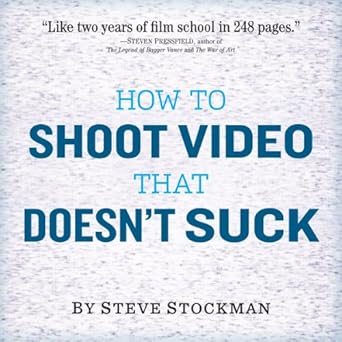This book is the perfect gift for any would-be filmmaker with the need to suck less. — Rob Barnett, Founder/CEO, MyDamnChannel. Everyone owns a video device. Which means the world is drowning in video, and most of it sucks. How to Shoot Video that Doesn’t Suck teaches you how to shoot video that people will actually want to watch.
My writing partner and I were arguing about a scene in a new screenplay. It’s a time-travel piece, and he wanted to explain all the technical steps that lead a character to have a conversation with someone from his distant past. The reason? So the audience would believe their meeting could plausibly happen.
Makes sense. If we don’t show how the machinery works in detail, and explain how the two accidentally met over miles and eons, who will believe it? Credibility comes from detail, right?
It makes sense, but it’s totally wrong. Extreme explanatory detail in a movie is death. We want the audience to believe the story, not write a dissertation on it. If we write a film correctly, the audience happily buys it despite having to leap across vast detail-less gaps. As proof, I offer you: The Abyss.
After Aliens and a few years before Titanic , James Cameron wrote and directed The Abyss. The film tells the story of petroleum workers living thousands of feet below the ocean’s surface. When a nuclear sub goes missing they’re recruited by the government to help rescue it– only to find that there’s an alien life-form doing mysterious things– in the Abyss. Dum dum dum…
My favorite thing about the Abyss: it takes place almost entirely on the ocean floor, but there’s not a single fish in the movie.
Technically that’s because Cameron shot most of the underwater scenes in a giant manmade tank. It was a difficult shoot, and trying to support living animals would have made it an impossible shoot. The digital technology of the day precluded layers of composite fish. Thus no fish in this underwater movie set in the ocean.
Does the script explain? Does a scientists character come forward to tell us why fish life around this part of the sea was wiped out, or refer to the region “the fishless void?” Nope, because that would focus our attention on the lack of fish. Instead the film ignores the obvious, tells a gripping action/romance with amazing digital aliens, and we never even think about the fish.
Beyond the normal audience suspension of disbelief (“For the next three hours, I will accept the existence of the Marvel Superheroes as if they are real”), all films require a high tolerance for reality violations. Why is the villain explaining so much before killing the hero? Would this romance really break up over such a minor lie? Why would a creature advanced enough to visit from another galaxy not have a foolproof way to protect itself from humans? How did those soldiers get all the way across Westeros so damn fast?
For most filmmakers, our first impulse is to explain everything. But explaining shines a spotlight on the problem. The art is in not explaining. Figuring out how to keep an audience with us while gliding over things that make no sense in real life.
Great filmmaking is magic, and like any magician, mis-direction is a key arrow in the quiver. Figure out how little information you can get away with and give them less than that. Resist explaining. Artfully treat odd things like they’re normal, and blow past them entertainingly enough to direct audience attention elsewhere.

And the next time you get stuck on a scene with tedious detail, remember: There are no fish in the Abyss.
Sometimes great storytelling is all detail- just not tedious detail. See Better Call Saul: the Devil is in the Details. I don’t see this as a contradiction, but let me know what you think in the comments.
Publisher Description
Newly updated and revised, How to Shoot Video That Doesn’t Suck is a quick and easy guide that will make your video better instantly—whether you read it cover to cover or just skim a few chapters. It’s about the language of video and how to think like a director, regardless of equipment (amateurs think about the camera, pros think about communication). It’s about the rules developed over a century of movie-making—which work just as well when shooting a two-year-old’s birthday party on your phone. Written by Steve Stockman, the director of the award-winning feature Two Weeks, plus TV shows, music videos, and hundreds of commercials, How to Shoot Video That Doesn’t Suck explains in 74 short, pithy, insightful chapters how to tell a story and entertain your audience. In other words, how to shoot video people will want to watch.
Here’s how to think in shots—how to move-point-shoot-stop-repeat, instead of planting yourself in one spot and pressing “Record” for five minutes. Why never to shoot until you see the whites of your subject’s eyes. Why to “zoom” with your feet and not the lens. How to create intrigue on camera. The book covers the basics of video production: framing, lighting, sound (use an external mic), editing, special effects (turn them off!), and gives advice on shooting a variety of specific situations: sporting events, parties and family gatherings, graduations and performances. Plus, how to make instructional and promotional videos, how to make a music video, how to capture stunts, and much more. At the end of every chapter is a suggestion of how to immediately put what you’ve learned into practice, so the next time you’re shooting you’ll have begun to master the skill. Steve’s website (stevestockman.com) provides video examples to illustrate different production ideas, techniques, and situations, and his latest thoughts on all things video.

I wish this book came with my video camera
I bought a video camera when my son was born and boy do I wish I had read this book then. After 9 months of aimlessly shooting and editing video I read this book and my shooting and edited movies instantly improved. Simple tips to help anyone improve their video skills told in a fun entertaining way with plenty of examples and exercises. Highly recommend to anyone who owns a video camera. Thanks Steve!
Simply inspiring
This book is the map and the inspiration that any film maker or film enthusiast should have under their belt. Full of ideas and motivational quotes and guidelines to keep you thinking and constantly improving. I want to shake Steve's hand. Now excuse me while I go shoot a masterpiece thanks to this book.
--Dan
More Books by Steve Stockman

